Making easy coconut curry sauce is simple. You just need coconut milk, curry powder, and garlic. These ingredients mix to create a bold flavor. It’s great for stir-fries, noodles, or as a dip.
If you’re new to cooking or want a quick sauce, this guide is for you. It shows how to mix spices and liquids into a smooth sauce. You don’t need special tools—just a blender or whisk and a pan.
Key Takeaways
- Use full-fat coconut milk for creaminess in your coconut curry sauce.
- Adjust spice levels by choosing mild or hot curry paste.
- Store leftovers safely to enjoy the sauce for up to five days.
- Pair the sauce with proteins like chicken, tofu, or shrimp.
- Add lemon juice to balance sweetness and tanginess.
Introduction: Discover the Origins and Appeal of Coconut Curry Sauce
Coconut curry sauce has won hearts around the world. It mixes old traditions with new cooking styles. Starting in places like Thailand, India, and the Caribbean, it grew from local ingredients and trade paths. The sauce’s creamy base, made with coconut milk and spices, adds depth and warmth that crosses cultural lines.
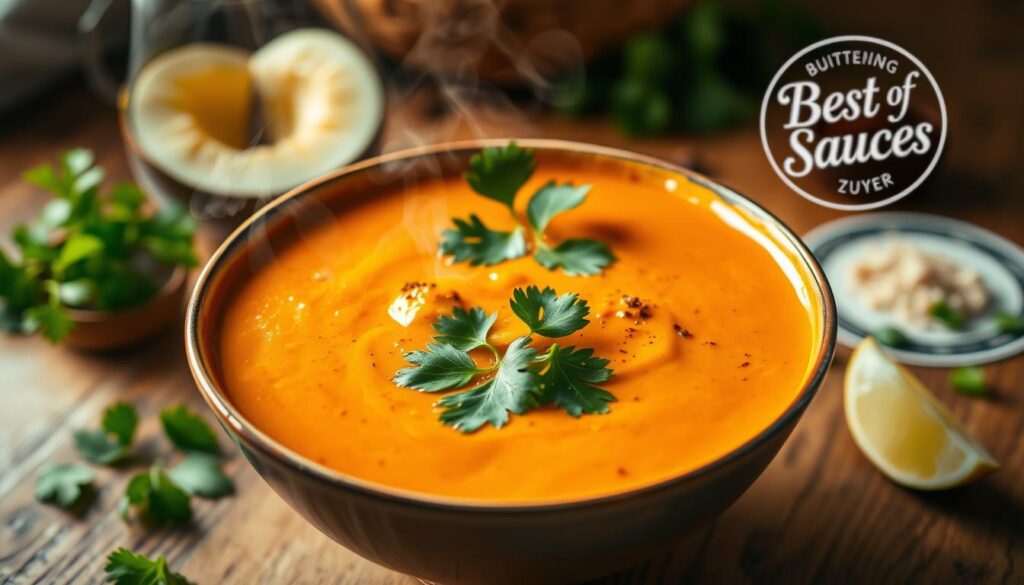
Now, coconut curry sauce is a favorite in kitchens everywhere. It’s great in stir-fries and bowls because it’s so versatile. Let’s dive into its story:
- Rooted in Southeast Asian street food
- Adopted by global fusion cuisines
- Adored for its velvety texture and bold flavors
| Region | Coconut Curry Sauce Style | Signature Flavors |
|---|---|---|
| Thailand | Spicy & aromatic | Lemongrass, galangal |
| India | Rich & layered | Cardamom, cumin seeds |
| Caribbean | Fiery & sweet | Scotch bonnet, tamarind |
From its simple start to today’s menus, coconut curry sauce fits any dish. It works well with proteins, grains, or as a dip. Whether you want the real deal or something new, this sauce has it all.
Ingredient Overview for a Delicious Dish
Every great spicy coconut curry sauce starts with the right ingredients. Let’s explore what makes this sauce special. Choose fresh, high-quality items for bold, balanced flavors.
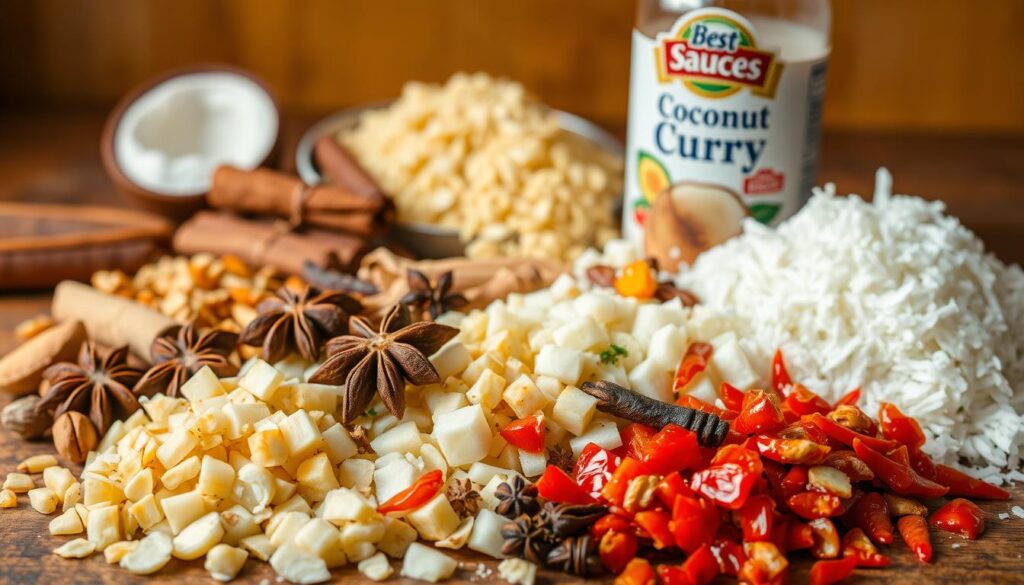
Fresh and Flavorful Produce
Fresh ingredients are key. Here are the must-haves:
- Coconut milk: Pick full-fat canned milk for creaminess.
- Red curry paste: Use Mae Ploy for real heat.
- Garlic and ginger: Grate or mince for a strong aroma.
- Lemongrass: Sauté the tender parts for citrusy depth.
Essential Herbs and Spices
Spices give the spicy coconut curry sauce its kick:
- Turmeric: Adds golden color and earthy warmth.
- Cumin and coriander: Toast them first for better flavor.
- Red chili flakes: Adjust to taste for a fiery finish.
- Cilantro and lime: Stir in at the end for bright freshness.
Pair these ingredients carefully. Too much chili? Balance with more coconut milk. Experiment to find your perfect taste. The right ingredients make every spoonful burst with authentic Southeast Asian flavor.
Step-by-Step Preparation Guide for Your coconut curry sauce
Learning to make homemade coconut curry sauce begins with preparation. Follow these steps to ensure every part works well together:
Preparing Your Ingredients
- Chop fresh ginger and garlic into fine pieces.
- Toast curry powder and cumin in a dry pan until fragrant.
- Drain canned coconut milk and set aside the thick cream for later.
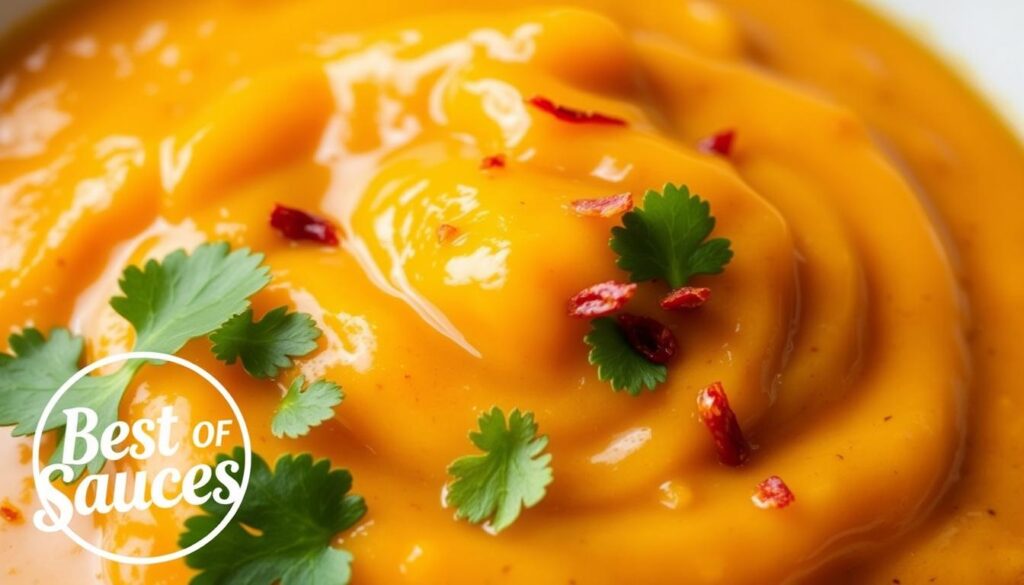
Cooking Techniques and Timing
Heat oil in a saucepan over medium heat. Sauté onions until they’re translucent. Then, add toasted spices.
Pour in coconut milk and simmer uncovered for 20-25 minutes. Use a spoon to scrape the bottom regularly to prevent burning.
“The key to balancing heat and sweetness lies in the simmering phase,” says Chef Maria Lopez of Thai Street Food Kitchen. “Never rush this step.”
Finishing Touches for Peak Flavor
- Stir in lime juice and fish sauce (or soy sauce for vegan options).
- Blend the sauce until smooth using an immersion blender.
- Taste and adjust saltiness or acidity to match your preference.
Store leftovers in an airtight container. This homemade coconut curry sauce is best used fresh. But it stays good for up to 5 days in the fridge.
Techniques for Creating Authentic coconut curry sauce
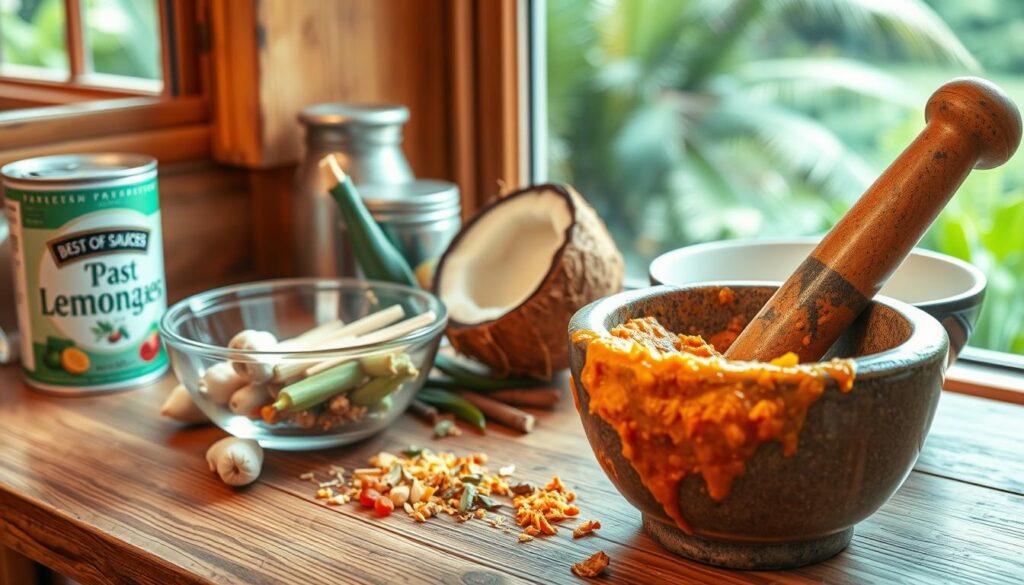
To make great thai coconut curry sauce, focus on traditional ways. First, mix sweet, salty, sour, and spicy flavors. Thai food is all about this balance. Use fresh stuff like lemongrass, galangal, and kaffir lime leaves for real taste.
- Toast spices before grinding to boost their smell. Heat a dry pan, add curry paste ingredients briefly, then grind to a paste.
- Simmer the sauce slowly. Low heat helps flavors mix well without burning. Stir now and then to keep it smooth.
- Adjust sweetness with palm sugar and saltiness with fish sauce. Keep tasting to get the flavors just right.
Using a traditional mortar and pestle helps spices mix evenly. Blenders work too, but pulse them to keep texture. Don’t make the sauce too thick—just enough to coat a spoon.
| Key Ingredient | Role in Sauce |
|---|---|
| Thai red curry paste | Core heat and herbaceousness |
| Lime juice | Adds bright acidity |
| Coconut milk | Base richness and creaminess |
Getting the right mix is key: 1 part curry paste to 4 parts coconut milk is good. Let it simmer for 20-30 minutes to let flavors grow. Don’t use pre-ground spices—freshly made paste tastes better.
Nutritional and Health Benefits of Coconut Curry Sauce
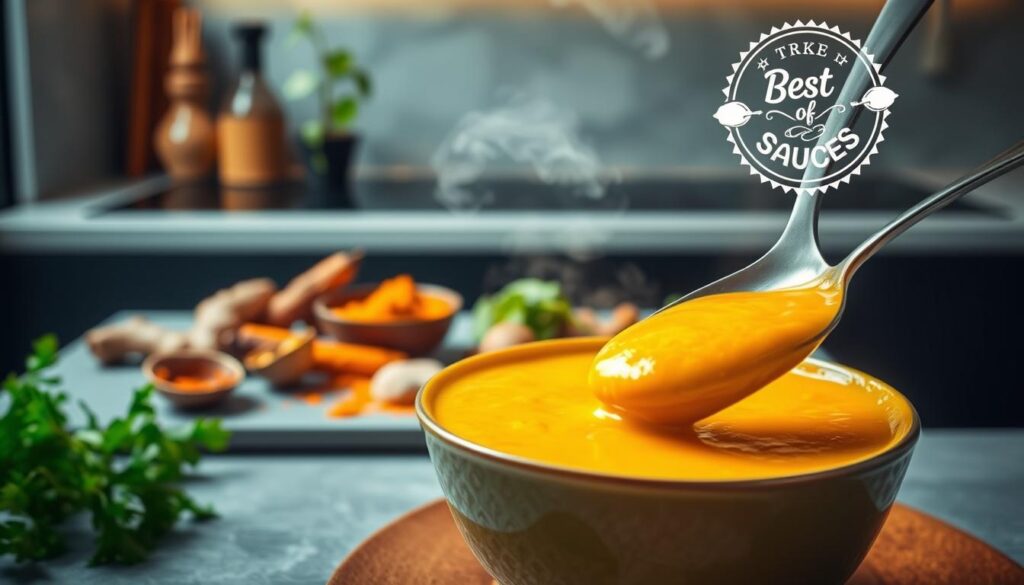
Every spoonful of authentic coconut curry sauce is more than just flavor. It’s a mix of nutrients that boost your health. This sauce is full of healthy fats from coconut milk. It also has vitamins like vitamin E and potassium from fresh ingredients.
Rich in Healthy Fats and Vitamins
- Coconut milk has medium-chain triglycerides, which give you energy and help with digestion.
- Herbs like cilantro and lime add vitamin C, which helps your immunity and skin.
- Potassium in coconut and spices helps keep your blood pressure in check.
Boost Your Metabolism with Spices
Spices like turmeric and ginger do more than just taste good. They boost your metabolism. Turmeric’s curcumin fights inflammation, and ginger helps with digestion. These spices work together to make your body feel alive without any artificial stuff.
Using authentic coconut curry sauce means you’re feeding your body with natural goodness. It’s great on veggies or proteins, adding flavor and energy to your meals.
Vegan and Gluten-Free Variations for Your Meal
Changing your vegan coconut curry sauce to fit dietary needs doesn’t mean losing flavor. You can easily swap out ingredients to keep your dish tasty and healthy. Start by using plant-based options that boost, not lessen, the flavor.
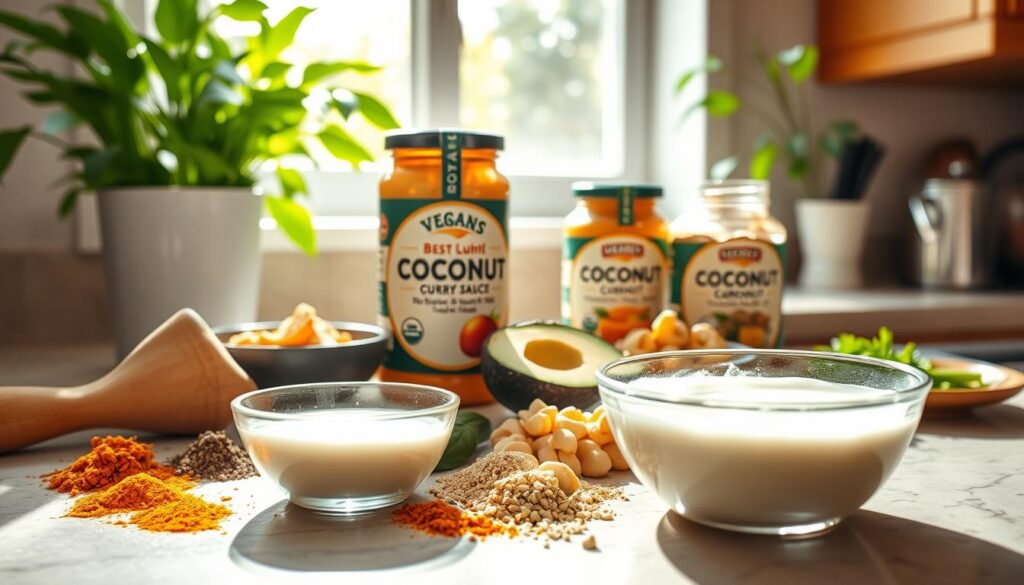
Substituting Dairy and Gluten Ingredients
- Swap regular milk for unsweetened almond or oat milk for creaminess.
- Choose gluten-free flour like arrowroot or cornstarch to thicken without allergens.
- Go for coconut aminos instead of soy sauce to dodge gluten.
| Traditional Ingredient | Vegan/Gluten-Free Swap |
|---|---|
| Heavy cream | Canned full-fat coconut milk |
| Wheat flour | Gluten-free tapioca flour |
| Regular broth | Vegetable broth certified gluten-free |
Enhancing Flavor while Keeping it Clean
Add these to boost umami:
- Roasted red pepper flakes for heat
- Coconut aminos for saltiness
- Fresh lime juice to brighten tanginess
Pair your vegan coconut curry sauce with rice noodles or quinoa for a full meal. It meets dietary needs without losing flavor.
Elevating Flavor with Spicy Coconut Curry Sauce Ideas
Turn your gluten-free coconut curry sauce into a spicy delight with these ideas. You can adjust the spice to your liking, from a gentle warmth to a fiery blast. Try these tips to make a sauce that will excite your taste buds.
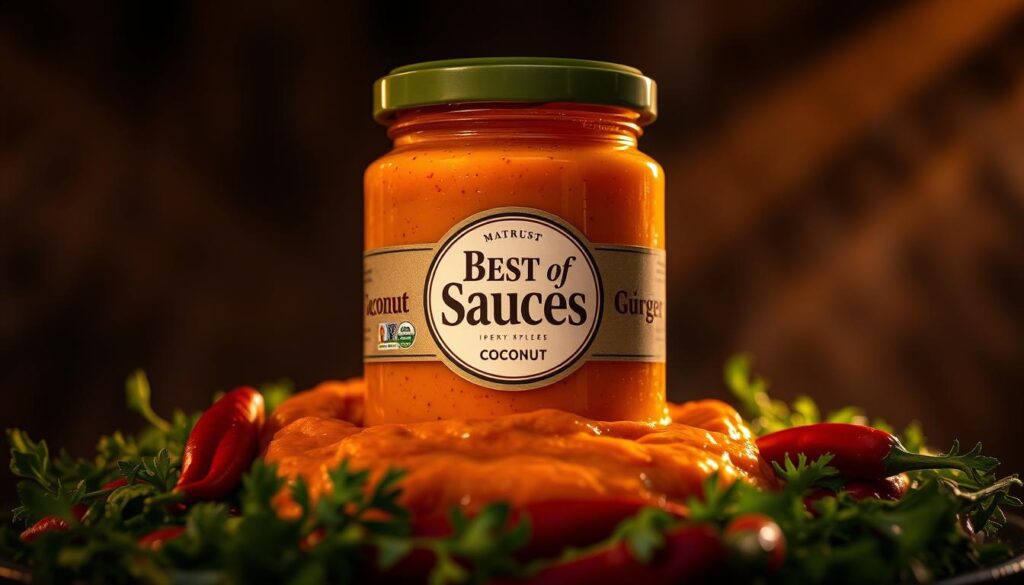
- Chili Paste Boost: Add a teaspoon of Thai Kitchen Red Curry Paste or Sriracha for a quick kick. Start with a small amount and adjust to taste.
- Fresh Chili Magic: Blend fresh Thai chilies into the sauce. Remove seeds for less heat or leave them in for more.
- Spice Blend Fusion: Add a pinch of smoked paprika or cayenne for depth. Mix in turmeric for a golden, aromatic touch.
Balance bold flavors with cool elements like fresh cilantro or coconut milk. Serve with tangy lime wedges or creamy rice to cool down the heat. These tweaks will let you tailor the sauce to your taste, whether it’s for tofu bowls or grain bowls.
Serving Suggestions and Pairings for Every Occasion
Turn your homemade coconut curry sauce into a full meal with these simple pairing ideas. Each bite will be a perfect mix of flavors when paired with the right sides.
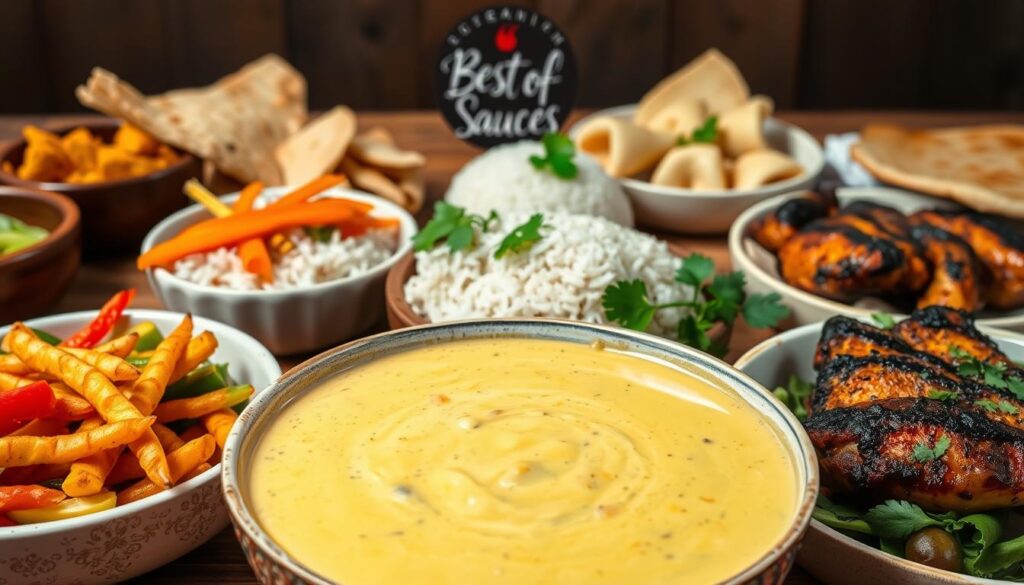
Pairing with Rice and Noodles
Start with these basics to make the sauce even richer:
- Jasmine rice or basmati rice for a classic choice.
- Rice noodles or udon for a fun chewy texture.
- Looking for something low-carb? Try cauliflower rice for a crunchy feel.
Complementary Side Dishes for Balance
Balance the bold flavors with these easy additions:
- Steam broccoli or asparagus for a fresh touch.
- Add a mango slaw for a burst of sweetness and acidity.
- Warm naan bread for a great sauce-soaker.
Pair with quick-pickled vegetables for a bright note. Choose your sides based on the meal’s spice level. Crisp salads cool down spicy dishes, while creamy sides soften the heat.
Storing and Preserving Your Homemade Coconut Curry Sauce
Keep your homemade coconut curry sauce fresh and flavorful with these storage tips. Proper methods ensure it stays safe and tasty for days or months.
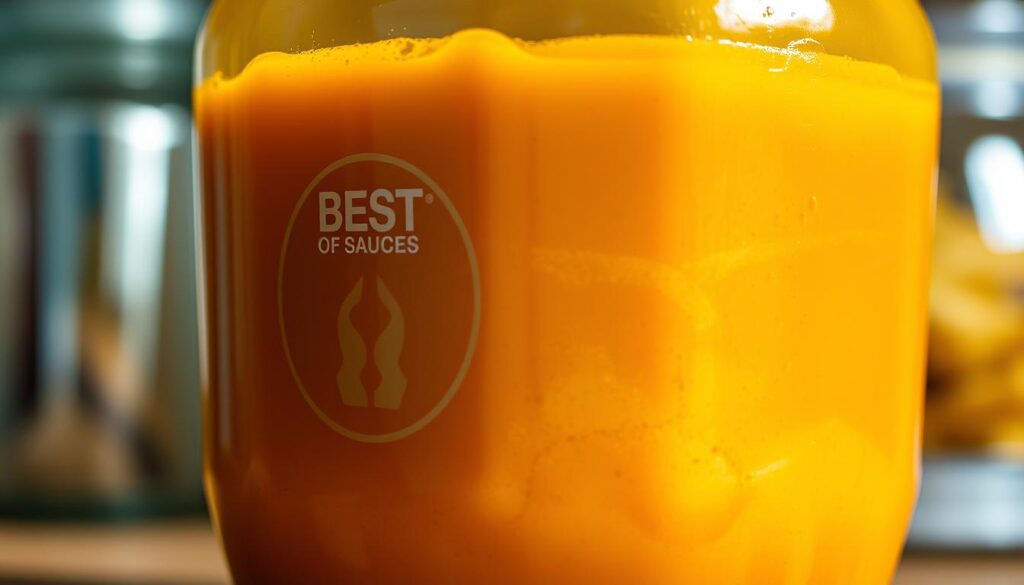
Best Practices for Refrigeration
Store sauce properly to maintain its quality:
- Use airtight containers like glass jars or plastic containers with secure lids.
- Keep in the refrigerator at 40°F (4°C) or below.
- Consume within 3–4 days for best taste and safety.
Reheat gently in a saucepan or microwave, stirring occasionally.
Freezing Techniques and Shelf Life
For longer storage, freeze portions:
- Pour sauce into ice cube trays for portion control.
- Transfer frozen cubes to freezer-safe bags or containers.
- Label containers with dates and thaw in the fridge overnight before use.
Freezer storage lasts up to 3 months. Avoid refreezing thawed sauce.
Always check the sauce’s smell and texture before use. Discard if off-odors or mold appear.
Adjust portions based on meal plans. Small batches reduce waste. Proper storage maintains the sauce’s creamy texture and bold flavors.
Troubleshooting Common Issues in Coconut Curry Sauce Preparation
Even seasoned cooks face challenges when making coconut curry sauce. Here’s how to fix common issues quickly:
| Problem | Solution |
|---|---|
| Sauce too thin | Simmer uncovered to reduce liquid or mix in 1 tsp cornstarch diluted in water. |
| Overly spicy | Cool heat with extra coconut milk or a spoonful of honey. |
| Lumpy texture | Strain through a sieve or blend until smooth using an immersion blender. |
Pro tip: Taste and adjust seasoning before adding thickeners. Overcorrections can alter the base flavor.
If the sauce curdles, remove from heat immediately. Whisk in 1-2 tbsp cold coconut milk to stabilize. For bland flavors, boost with fish sauce or lime juice. Always store leftovers in a sealed container to prevent separation.
Conclusion
Making coconut curry sauce at home is a game-changer for your meals. It’s easy to make with fresh ingredients and spices. This sauce is great for those who follow vegan or gluten-free diets.
It’s full of healthy fats and spices that boost your metabolism. You can use it to make rice, noodles, or veggies taste amazing. Or, add it to proteins for a full meal.
Feel free to adjust the spice level to your liking. And don’t forget to store leftovers properly for a quick fix. This sauce is more than just a condiment; it’s a key to exploring new flavors.
Whether it’s for a weeknight dinner or a special event, coconut curry sauce is versatile. It lets you get creative in the kitchen. So, go ahead and experiment with it. You’ll find endless ways to use it.
FAQ
What ingredients do I need for an easy coconut curry sauce?
To make an easy coconut curry sauce, you’ll need coconut milk, curry paste, garlic, and ginger. Choose your favorite vegetables too. For a real taste, add spices like cumin and turmeric.
Can I make a spicy coconut curry sauce?
Yes, you can! Add more curry paste or chili peppers for spice. Red pepper flakes or chopped chili can also add heat.
Is there a vegan version of coconut curry sauce?
Yes, coconut curry sauce is vegan. Use coconut milk and vegetables. Make sure your curry paste is animal-free.
How do I make homemade coconut curry sauce from scratch?
Making homemade coconut curry sauce is easy. Start by sautéing onions, garlic, and ginger. Then, add your curry paste. Stir in coconut milk and simmer until it thickens.
Is coconut curry sauce gluten-free?
Yes, coconut curry sauce can be gluten-free. Use gluten-free curry paste. Also, check that any soy sauce is gluten-free.
What dishes pair well with coconut curry sauce?
Coconut curry sauce goes great with rice, noodles, and veggies. It’s also good with tofu, chickpeas, or chicken for a full meal.
How can I enhance the flavor of my coconut curry sauce?
To make your coconut curry sauce better, add fresh herbs like cilantro or basil. Lime juice adds zest. Roasted veggies can also enhance the flavor.
How long can I store homemade coconut curry sauce?
Homemade coconut curry sauce can be stored in the fridge for a week. Or, freeze it for three months. Keep it in an airtight container to stay fresh.
What are the health benefits of coconut curry sauce?
Coconut curry sauce is full of healthy fats from coconut milk. It also has vitamins and minerals from veggies. The spices can boost your metabolism and health.
Can I adjust the thickness of my coconut curry sauce?
Yes, you can. For a creamier sauce, add more coconut milk. For a thicker sauce, simmer it longer.

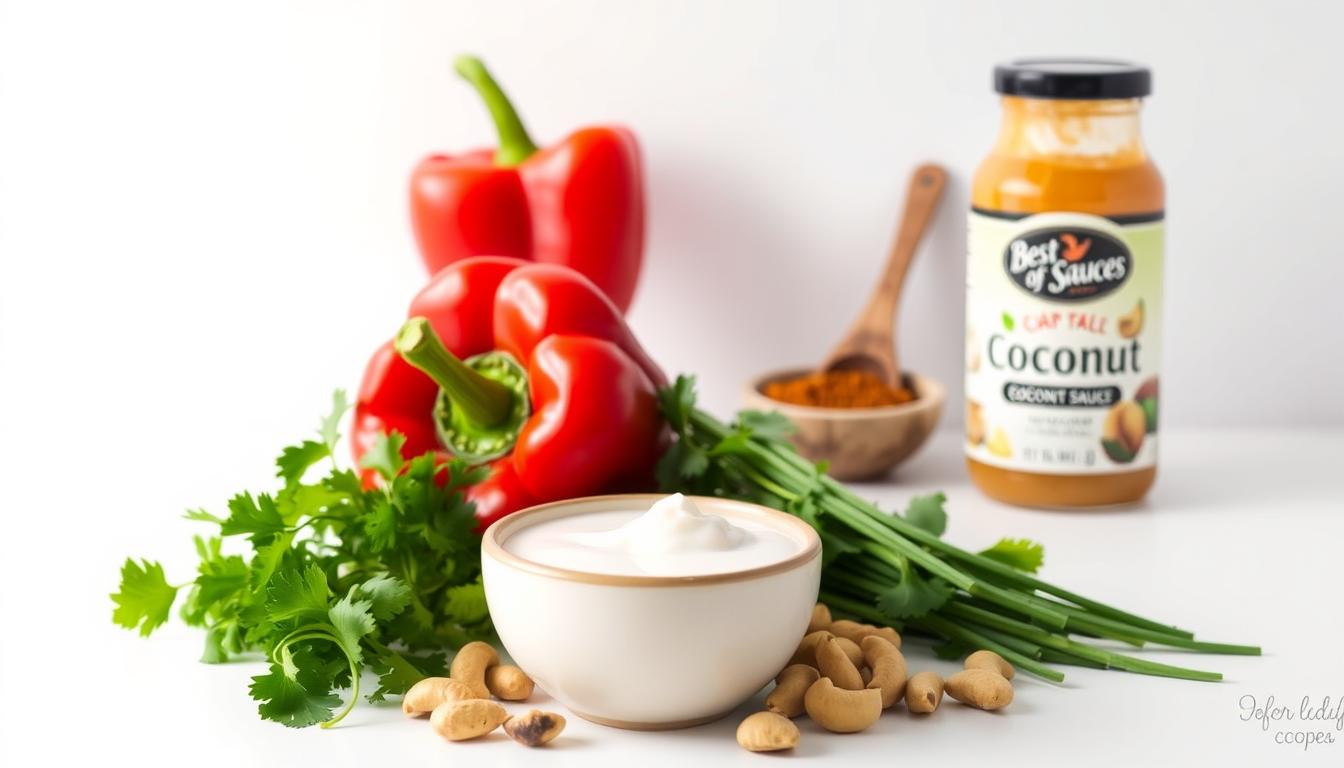
1 thought on “Easy Coconut Curry Sauce Recipe for Tasty Dishes”